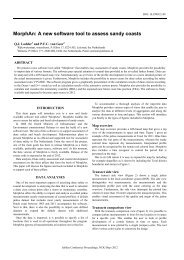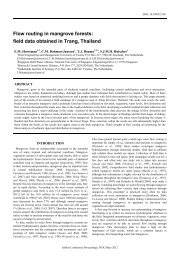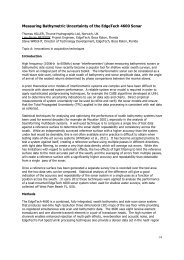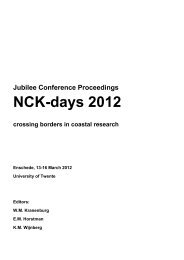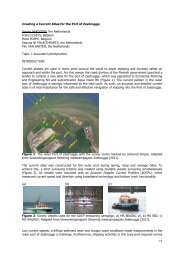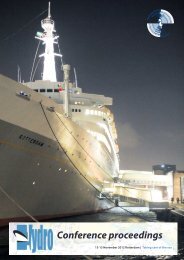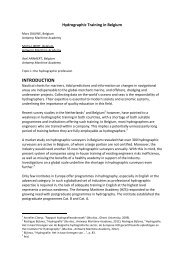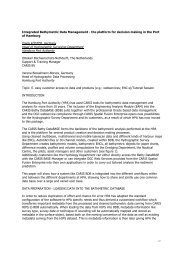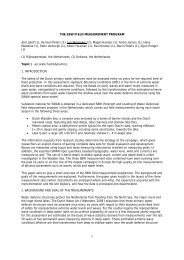1/6 Sediment waves: geohazard or geofeature ... - UT Proceedings
1/6 Sediment waves: geohazard or geofeature ... - UT Proceedings
1/6 Sediment waves: geohazard or geofeature ... - UT Proceedings
Create successful ePaper yourself
Turn your PDF publications into a flip-book with our unique Google optimized e-Paper software.
<strong>Sediment</strong> <strong>waves</strong>: <strong>geohazard</strong> <strong>or</strong> <strong>geofeature</strong>?<br />
Vict<strong>or</strong>ia P<strong>UT</strong>ANS, Russia<br />
P.P.Shirshov Institute of Oceanology, RAS<br />
Topic H: geophysics of the marine environment<br />
INTRODUCTION<br />
The term “sediment <strong>waves</strong>” fully established in Special issue of Marine Geology [192, 2002] presents<br />
large-scale depositional bedf<strong>or</strong>ms in various parts of W<strong>or</strong>ld Ocean. These undulating objects usually<br />
have is tens of meters to a few kilometers in wavelength and are several meters high and were<br />
generated beneath a near-bottom current <strong>or</strong> turbidite <strong>or</strong> both. The main question about the<br />
sedimentary wavy features was, and is, to distinguish them from soft sediment def<strong>or</strong>mations. The<br />
criteria f<strong>or</strong> such distinguishing is a) accurate processing of seismic sections to reveal whether the<br />
faults are real, b) top-wings granulometric distribution, c) regular m<strong>or</strong>phology with obvious<br />
distribution law, d) f<strong>or</strong>m of crests in plan view. However, “current vs creep” argument is still common<br />
even f<strong>or</strong> some well-known “wave fields” [e.g. Berndt et al., 2006].<br />
W<strong>or</strong>ldwide investigations of last decade revealed these controversial geom<strong>or</strong>phologic features in<br />
different geological and paleogeological environments, including ones connected with oil, gas, and gas<br />
hydrates fields [Riedel et al., 2010; Heinio &Davies, 2009; Holbrook et al., 2002]. The revealed facts<br />
that sediment <strong>waves</strong> a) can be not only confused with but be complicated by creep processes<br />
[Mitchell&Huthnance, 2007], b) are evidence f<strong>or</strong> present <strong>or</strong> past active environment, e.g. turbid flows,<br />
trigging, gas eruption [Putans et al., 2010], c) due to lithologically s<strong>or</strong>ted material can be small-scale<br />
reservoirs both f<strong>or</strong> free gas and fluids [Wynn et al., 2007, Booth et al., 2003], lead to assumption that<br />
presence of these <strong>geofeature</strong>s may be direct indicat<strong>or</strong> of “geological state that represents <strong>or</strong> has the<br />
potential to develop further into a situation leading to damage <strong>or</strong> uncontrolled risk” e.g. <strong>geohazard</strong>.<br />
However, the same facts could reveal sediment <strong>waves</strong> themselves as treacherous features.<br />
Due to recently increased awareness of ecological consequences of offsh<strong>or</strong>e expl<strong>or</strong>ation, <strong>geohazard</strong><br />
estimation has become the first thing to do especially in marine environment. Since any sea is very<br />
sensitive to any external impact, any inf<strong>or</strong>mation on risk criteria could be vital. Processing of<br />
seismoacoustic data and analysis of acoustic field anomalies are primary methods of geophysical<br />
survey. Re-interpretation and comparative analysis could be of much help in estimation of potential<br />
hazards and especially in distinguishing perilous setting and safe <strong>geofeature</strong>s. The paper represents<br />
such analysis made by P.P.Shirshov Institute of Oceanology RAS on examples from Caspian Sea.<br />
GEOLOGICAL SETTING<br />
Caspian Sea is a huge (1200km x 300km) in-land depression, isolated from W<strong>or</strong>ld Ocean.<br />
M<strong>or</strong>phologically Caspiy can be divided into three regions: N<strong>or</strong>thern (vast shelf plains), Central<br />
(depression, average depth 300m, maximum depth – 700m) and South (depression, average depth<br />
500m, maximum > 1000m). Natural b<strong>or</strong>ders of these regions are Mangyshlak Threshold (sediment<br />
bow-shaped body) between N<strong>or</strong>th and Central parts and Apsheron Threshold (linear tectonic<br />
elevation) between Central and South parts (Figure 1). Significat regional processes are neotechtonic<br />
movements and great amount of deep-focus earthquakes (up to hundred each year). This trigging<br />
initiates mud vocano activity and mass movements on slopes of both deep basins. On the other hand,<br />
sedimentation processes in Caspian are controlled by bottom topography and sources of sedimentary<br />
material (rivers runoff first of all). The most famous Caspian pequliarity is its ever-lasting<br />
unpredictable level-change which is impossibble to c<strong>or</strong>relate definitely neither with W<strong>or</strong>ld Ocean n<strong>or</strong><br />
with glaciation hist<strong>or</strong>y.<br />
1/6
Figure 1 (left): Geom<strong>or</strong>philigy scheme combined with scheme of heat flow from [Glumov, 2004].<br />
Heat flow: A – most active, B – active, C – high; D – location of profiles on figures 2 and 3.<br />
Figure 2 (right): Vertical degazation zones and pockmarks in bottom relief. 1 – top of gas hydrate<br />
degradation layer; 2 – falures; 3 – gas pipes; 4 – pokmarks.1<br />
Maj<strong>or</strong> hydrocarbon fields are situated on the N<strong>or</strong>thern shelf and in deep Southern basin, and several<br />
prospective sructures occur in Central basin. There is a general distribution rule: main oil fiels are<br />
situated nothward from Apsheron threshold and main gas fields southward. Such situation is due to<br />
sedimetation hist<strong>or</strong>y and heat flow which is especially great near Apsheron threshold. Nevertheless,<br />
gas-saturated sediments in different f<strong>or</strong>ms occur nearly everythere in Caspian. Most usual acoustic<br />
anomaly f<strong>or</strong> such sediments is ”bright spot”, but spectatular gas pipes exists as well (Fig.2).<br />
Beside oil and gas fields, Caspian sea seems to have several fields of gas hydrates with different gas<br />
types. During intensive expropation in South Caspian gas hydrates were discovered offsh<strong>or</strong>e<br />
Azerbaijan both on the top of mud volcanoes [Ginsburg & Soloviev, 1994] and in fairly undisturbed<br />
sedimentary section by clear seismic BSR [Diaconescu et al., 2001]. Zones A on heat flow map<br />
adopted from Glumov [2004] on Figure 1 c<strong>or</strong>relate with “allowed existence” areas caluculated from<br />
parameters in Diaconesu [2001].<br />
STUDY METHODS<br />
During recent investigations of P.P.Shirshov Institute of Oceanology seismoacoustic data was aquired<br />
by several hardware sets (Table 1). A global positioning system (DGPS) provided vessel position with<br />
an accuracy 0.5-5.0 m. Polygons consist of <strong>or</strong>thogonally <strong>or</strong> obliquely crossing survey lines. The<br />
deposits have been sampled with gravity c<strong>or</strong>es 15 cm in diameter and up to 4m deep. Grain size<br />
analyses were made in MSU lab<strong>or</strong>at<strong>or</strong>ies with standard methods. Volume density of unstrained and<br />
wet sediment was calculated by cutting ring method. Seismoacoucstics data was processed in<br />
2/6
RadExPro seismic processing program with standard alg<strong>or</strong>ithm (muting, filtration, sometimes<br />
deconvolution). Plastic models, based on density and geometry, were calculated in FLAC 3D .<br />
Table 1: Hardware parameters<br />
Type Function Frequency<br />
range (kHz)<br />
Penetration<br />
(depend on sediments)<br />
Vertical<br />
resolution<br />
Sparker Seismoacoustic 0.2-0.7 50m - 300m 2-3m<br />
SES – 2000 Echo-sounder + 100kHz<br />
10m - 50m<br />
0.05-0.15m<br />
standart seismoacoustical<br />
profiler (tone signal)<br />
4-12kHz<br />
CHIRP-II Seismoacoustic profiler<br />
with swip signal<br />
2-7 kHz 2m - 50m 0.2-0.5m<br />
RESULTS<br />
Seismoacoustic data of high resolution shows distinct zonality of geom<strong>or</strong>phology and acoustic<br />
anomalies: bright spots and numerous filled paleovalleys in N<strong>or</strong>thern Caspian; fans and paleodeltas on<br />
Mangyshlak theshold with creep zone and channel system down to Cenral basin; gas chimnes and<br />
unexpected mud volcano in basin itself; series of modern faults on Apsheron threshold; several fans<br />
and gas escaping zones in Southern Caspian.<br />
The most significant event of recent years was discovery of several types of sediment <strong>waves</strong> on slopes<br />
of Central basin. The most vast (~150km x 50km) field is situated on western slope of the Central<br />
Basin (Fig. 3). Previously, these f<strong>or</strong>ms were interpreted as creep, but reinterpretation of old and<br />
obtaining new data showed all distinctions of mixed sediment <strong>waves</strong> (see Introduction). There are<br />
several generations of <strong>waves</strong>, interbedded with conf<strong>or</strong>m parallel deposits. Geological samples show<br />
numerous sand/clay thin layers. The whole sequence age is 700kyr and it has f<strong>or</strong>m of a wedge<br />
between the shelf break and the steep step down to abyssal.<br />
Figure 3: <strong>Sediment</strong> was on Derbent slope (Central Caspian). None zones of acouatic shadows on<br />
Sparker profile and reflections in water on SES data.<br />
The second area of sediment <strong>waves</strong> is on levees of channels/canyons on Mangyshlak Thresold.<br />
Compund fan of paleo Volga, paleo Terek and paleo Ural represents a highly complicated system with<br />
inflows and meanders, both recent and old (up to 600 kyr). <strong>Sediment</strong> <strong>waves</strong> on levees show different<br />
m<strong>or</strong>phology, probably because of not precisely n<strong>or</strong>mal transsections. Samples show thin material<br />
(clay). The very recent studies (2012) reveal the third sediment <strong>waves</strong> field on n<strong>or</strong>thern slope of<br />
Apsheron threshold. However it is a matter of future research.<br />
3/6
In close neighboughood with levee exists creep area. Folds have “classical” creep shape: flat tops,<br />
narrow valleys, irregular m<strong>or</strong>phology and geometry. As well as on other ”wavy” fields, there are<br />
several “generations” of creep folds, each slightly differs from others. Geological c<strong>or</strong>es show watersaturated<br />
plastic clay.<br />
Due to tectonic activity of the region, there are a lot of faults and failure of different scale. These<br />
features are inevitably connected to vertical zones without c<strong>or</strong>relation (pipes and chimneys). Most of<br />
these zones ends with pockmarks in bottom relif (Fig.2). The other end connects with vast zone of<br />
chaotic reflections, both in Central ans South Caspian. However, n<strong>or</strong>thward from Asheron Threshold<br />
there are three such zones on different levels and none of them comes up to bottom surface, whlie<br />
sothward the zone occure just below holocene sediments.<br />
DISCUSSION<br />
Due to recently increased interest to gas hydrates and awareness of ecological consequences of<br />
hydrocarbon expl<strong>or</strong>ation, auth<strong>or</strong> put special attention on c<strong>or</strong>relation between sediment <strong>waves</strong>, gas<br />
escaping structures and gas hydrates with their principle evidence bottom-simulating reflect<strong>or</strong>s (BSR).<br />
Indeed, all these features seem to show up together on perspective hydrocarbon fields. The most<br />
obvious explanation to this c<strong>or</strong>relation could be unstable environment which w<strong>or</strong>ks both ways:<br />
endogenous processes f<strong>or</strong>m rough relief, cause trigging, sedimentation results in wavy f<strong>or</strong>ms, which<br />
could a) be unstable <strong>or</strong> b) accumulate escaping gas due to well s<strong>or</strong>ted material. The most noticeable<br />
is escaping of free gas below BSR <strong>or</strong> from dissociated gas hydrates layers. Such c<strong>or</strong>relation is not<br />
absolute and requires further investigations. However, it is possible to classify two types of “gassediment<br />
<strong>waves</strong>” relation: a) direct escaping of gas through wavy features; b) geological association<br />
“sediment <strong>waves</strong> – BSR” on seismoacoustic transects.<br />
Interpretation of high resolution profiles on Caspian Sea, taken in framew<strong>or</strong>k of this conception,<br />
provides good evidence f<strong>or</strong> such distribution. F<strong>or</strong> example, on Derbent slope there are several “bright<br />
spots” and escaping chimneys. Modeling of plastic def<strong>or</strong>mation shows that wedge of sediment <strong>waves</strong><br />
on Derbent slope is stable, while creep on the n<strong>or</strong>thern slope is in continuous flowing. Between them<br />
sets channel system which indicates active hydrodynamics in recent past <strong>or</strong> present. Several levels of<br />
this system also have “bright spot” anomalies and series of possible gas-escape unconf<strong>or</strong>mities. Thus<br />
it is possible to declare that in Central Caspian sediment <strong>waves</strong> are evidenses of <strong>geohazard</strong>s [Putans<br />
et al., 2010]. But the flow and fluxes are not the only <strong>geohazard</strong> sediment <strong>waves</strong> could be conected<br />
with.<br />
Just nearby last levee starts acoustic anomaly of great disturbance. This anomaly is connected to gas<br />
pipes and is believed to be weak layer of dissociated gas hydrates. Presence of free gas could be<br />
dangerous f<strong>or</strong> drilling on nearby structures, and further southward. Data from Apsheron Threshold<br />
and Southern Caspian provides evidence of shallow BSRs. At the same time, Caspian data shows<br />
unusual acoustic pattern as mirr<strong>or</strong>ed reflection. Very acoustically sharp layer “mirr<strong>or</strong>s” bottom relies<br />
so that at first glance it could be confused with BSRs and. Interesting fact is, that such effect occurs<br />
nearby gas escaping areas.<br />
CONCLUSION<br />
Are sediment <strong>waves</strong> <strong>geohazard</strong>s <strong>or</strong> just <strong>geofeature</strong>? After one had found some ”wavy” m<strong>or</strong>phology<br />
and classified it as creep, we are talking of <strong>geohazard</strong>, on the other way it seems undisturbed<br />
accumulative object. Nevetheless, every sediment wave field is (<strong>or</strong> was) f<strong>or</strong>ming in active environment<br />
such as water flow <strong>or</strong> turbidite. Two latter are treacherous processes, escpecially f<strong>or</strong> pipelines: erosion<br />
could cause stretching while intensive sediment input could bury pipe. Other exploitetion and<br />
expl<strong>or</strong>ation risks are solifluction under pressure of platf<strong>or</strong>m basement and gas explosion. Thus such<br />
geofetures as sediment <strong>waves</strong> should serve as a warning and to think in advance of anthropogenic<br />
impact and to take care of the sea.<br />
4/6
The presented study was partially supp<strong>or</strong>ted by RFBR, research project No.12-02-00543-а<br />
REFERENCES<br />
Marine Geology, (2002), vol.192<br />
Berndt, C., Bünz, S., Clayton, T., Mienert, J., Saunders, M. (2004). Seismic character of bottom<br />
simulating reflect<strong>or</strong>s: Examples from the mid-N<strong>or</strong>wegian margin // Marine and Petroleum Geology 21<br />
(6), pp.723-733<br />
Booth J.R., Dean M.C., DuVernay A.E. III, Styzen M.J. (2003). Paleo-bathymetric controls on the<br />
stratigraphic architecture and reservoir development of confined fans in the Auger Basin: central Gulf<br />
of Mexico slope // Marine and Petroleum Geology, v. 20, p. 563–586.<br />
Diaconescu C.C., Kieckhefer R.M., Knapp J.H. (2001). Geophysical evidence f<strong>or</strong> gas hydrates in the<br />
deep water of the South Caspian Basin, Azerbaijan Marine and Petroleum Geology 18, pp.209±221<br />
Ginsburg, G. D., & Soloviev, V. A. (1994). Mud volcano gas hydrates in the Caspian Sea // Bulletin of<br />
the Geological Society of Denmark, 41, 95±100<br />
Glumov I.F., Malovitskiy Ya.P., NovikovA.A., Senin B.V. (2004) Regional geology and oil and gas<br />
content of Caspian Sea. (In Russian) Moscow, Nedra<br />
Heinio P., Davies R.J. (2009). Trails of depressions and sediment <strong>waves</strong> along submarine channels on<br />
the continental margin of Espirito Santo Basin, Brazil // Geological Society of America Bulletin, v.121,<br />
no.5-6, p.698-711<br />
Holbrook W.S., Lizarralde D., Pecher I.A., G<strong>or</strong>man A.R., Hackwith K.L., H<strong>or</strong>nbach M., Saffer D. (2002).<br />
Escape of methane gas through sediment <strong>waves</strong> in a large methane hydrate province // Geology,<br />
v.30, pp. 467-470<br />
Mitchell N.C., Huthnance J. M. (2007). Comparing the smooth, parabolic shapes of interfluves in<br />
continental slopes to predictions of diffusion transp<strong>or</strong>t models // Marine Geology 236, 189–208<br />
Putans V.A., Merklin L.R., Levchenko O.V. (2010). <strong>Sediment</strong> <strong>waves</strong> and other f<strong>or</strong>ms as evidence of<br />
<strong>geohazard</strong>s (Caspian Sea) // International Journal of Offsh<strong>or</strong>e and Polar Engineering. Vol. 20, No. 4<br />
Riedel, M., Collett, T.S., and Malone, M., (2010). Expedition 311 synthesis: scientific findings // In<br />
Riedel, M., Collett, T.S., Malone, M.J., and the Expedition 311 Scientists, Proc. IODP, 311:<br />
Washington, DC (Integrated Ocean Drilling Program<br />
Wynn R.B., Cronin B.T., Peakall J. (2007). Sinuous deep-water channels: Genesis, geometry and<br />
architecture // Marine and Petroleum Geology 24, pp. 341–387<br />
BIOGRAPHIES<br />
Vict<strong>or</strong>ia P<strong>UT</strong>ANS, researcher in Seismostratigraphy lab in P.P.Shirshov Institute of Oceanology, RAS<br />
(IORAS). Since 2003 w<strong>or</strong>ked as part-time engineer in the IO RAS while being full-time student of<br />
Russian State Geological Prospecting Univ. (RSGPU), Geophysical Dept. Graduated RSGPU in 2007 as<br />
Mining engineer in geoghysical methods of prospecting and survey, Seismics. Continued in IO RAS as<br />
PhD student and recieved PhD in Oceanology in 2010. Participant of several international scientific<br />
projects, experience in expl<strong>or</strong>ation projects f<strong>or</strong> Lukoil company. Current scientific interests:<br />
seismoacoustics, <strong>geohazard</strong>s, sea-level change, marine expl<strong>or</strong>ation, all range of sedimentation<br />
processes.<br />
5/6
CONTACT DETAILS<br />
Vict<strong>or</strong>ia P<strong>UT</strong>ANS<br />
P.P.Shirshov Institute <strong>or</strong> Oceanology, RAS<br />
36, Nokhimovskiy prospekt<br />
Moscow<br />
RUSSIA<br />
Tel.: +79263193636<br />
Fax: +499124<br />
Email: vitapu@mail.ru; vitapu@ocean.ru<br />
Web site: www.ocean.ru<br />
6/6





